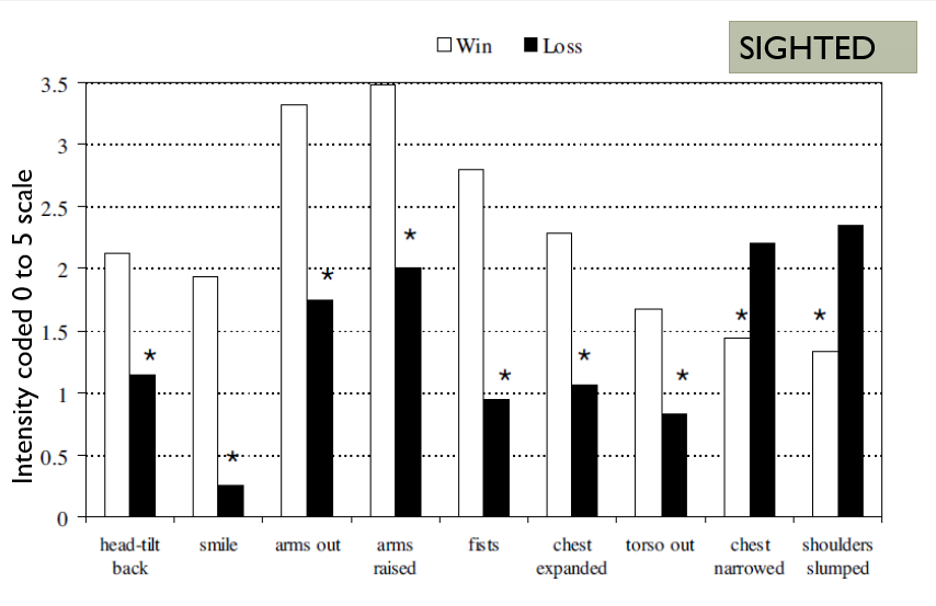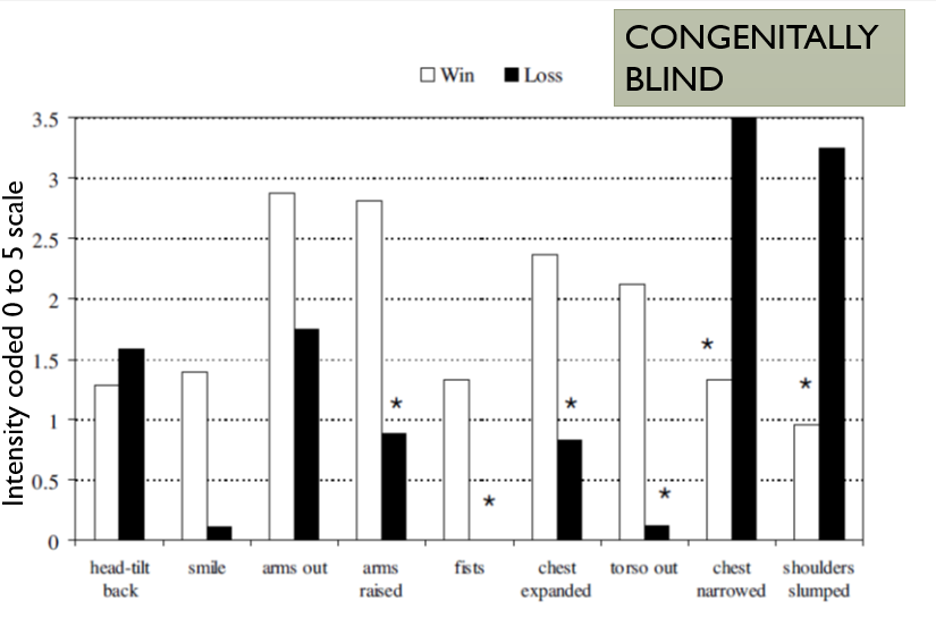Chapter 12: Pride – A Positive Self-Conscious Emotion
Self-Conscious Emotions: Are They Universal?
Behavior Changes
In this section, we will review an interesting study that sought to determine whether bodily changes of pride and shame are universal. Tracy and Matsumoto (2008) recruited three groups of participants from the judo matches at the Olympics and ParaOlympics: sighted individuals, congenitally blind individuals, and late-onset blind individuals. It is important to note that the sighted and late-onset participants are those who could have learned to express bodily changes for self-conscious emotions by watching other people. Congenitally blind participants, who have never been able to see, would be less likely to have learned which bodily changes accompany self-conscious emotions. Thus, if congenitally blind participants show the same bodily changes as the other two groups, this would provide evidence that these body and facial changes are innate and universal.
Quasi-IV #1: Participants Groups: Sighted vs. Congenitally Blind vs. Late-Onset Blindness
Quasi-IV #2: Whether participants won or lost the ParaOlympics event.
Dimensional Variable: Collectivism-Individualism of 37 Countries.
DV #1: On a 0 to 5 scale, researchers coded the intensity of shame and pride behavior changes.
Pride Behavior Changes included:
- Head-Tilt Back
- Smile
- Arms Out
- Fists
- Chest Expanded
- Torso Out
Shame Behavior Changes included:
- Chest Narrowed
- Shoulders Slumped
Figure 16 displays the findings for sighted individuals and Figure 17 displays the findings for congenitally blind individuals. Sighted individuals who won their event displayed greater intensity for the 6 pride behavior changes compared to sighted individuals who lost. Sighted individuals who lost displayed more intense chest narrowed and shoulders slumped compared to sighted individuals who won. Taken together, these findings suggested sighted individuals who won expressed pride behaviors, while sighted individuals who lost expressed shame behaviors.
Figure 16
Pride and Shame Behavior Changes for Sighted Individuals

Long Description
The image is a bar graph depicting the intensity of certain body language movements coded on a scale from 0 to 5. The graph compares movements associated with wins, represented by white bars, and losses, represented by black bars. The x-axis labels different movements: head-tilt back, smile, arms out, arms raised, fists, chest expanded, torso out, chest narrowed, and shoulders slumped. The y-axis indicates the intensity scale from 0 to 3.5. For winning, the most intense movements are “arms out” and “arms raised.” For losing, “chest narrowed” and “shoulders slumped” have the highest intensity. Asterisks mark significant differences between winning and losing for most movements. In the upper right, a note reads, “SIGHTED.”
Reproduced from “The spontaneous expression of pride and shame: Evidence for biologically innate nonverbal displays” by J.L. Tracy and D. Matsumoto, 2008. ( Proceedings of the National Academy of Sciences, 105(33), p. 11656) Open Access, PNAS.
Figure 17
Pride and Shame Behavior Changes for Congenitally Blind Individuals

Long Description
The image is a bar graph displaying the intensity of certain expressions coded on a scale from 0 to 5. The graph is titled “CONGENITALLY BLIND” in the upper right corner. The y-axis represents “Intensity coded 0 to 5 scale,” ranging from 0 to 3.5 in increments of 0.5. The x-axis lists various physical expressions: head-tilt back, smile, arms out, arms raised, fists, chest expanded, torso out, chest narrowed, and shoulders slumped. Each expression is represented by two bars, one for “Win” (white) and one for “Loss” (black). The graph shows differences in the intensity of these expressions between the two conditions, with notable variations indicated by asterisks (*) beside certain expressions. For instance, “chest narrowed” and “shoulders slumped” show higher intensity for “Loss.”
Reproduced from “The spontaneous expression of pride and shame: Evidence for biologically innate nonverbal displays” by J.L. Tracy and D. Matsumoto, 2008. ( Proceedings of the National Academy of Sciences, 105(33), p. 11657) Open Access, PNAS.
In this study, individualism-collectivism moderated the relationship of loss/win on shame facial expressions. This moderation means that individuals from collectivist cultures showed greater shame bodily changes after winning. Individualism-collectivism did not moderate the effect of winning on pride behavior changes. In general, this study shows that some behavior changes are universal and some are not. One limitation is that there might be ways that congenitally blind participants could learn about the behavior changes typical for shame and pride, which would contradict basic emotion theory. Interestingly, congenitally blind participants (versus late-onset blind participants) showed greater intensity of expression for both shame behaviors. In other words, congenitally blind participants slumped their shoulders more and narrowed their chest more. This seems to contradict basic emotion theory. Why do you think congenitally blind individuals expressed more shame?
One last study (Elfenbein et al., 2007) evaluated shame and embarrassment facial expressions for participants living in Quebec versus Gabon. Quebec and Gabon are both French-speaking regions and were once French colonies, so they may hold some similarities. In this study, both participant groups were given a list of 10 emotion words and instructed to pose each emotion on their face like they were expressing this emotion to a friend. In addition, participants were given a mirror to make the facial expression! Then, researchers coded the action units displayed by participants. Results show that individuals living in Quebec and Gabon both posed the same action units for embarrassment. Cultural differences were found for the shame expression. Individuals from Gabon showed changes in only AU54 (head down) or a combination of AU32 (lip bite) and AU54, while Quebecois showed changes in AU 4 (brow lowerer) and AU 14 (dimpler). Examples of the shame expressions are shown in Figure 18. What emotion do you think is displayed on the face of the Quebec individual in the figure below?
Figure 18
Examples of Shame Expressions for Gabonese (left and right) and Quebecois (middle)

Reproduced from “Toward a dialect theory: Cultural differences in the expression and recognition of posed facial expressions,” by H.A. Elfenbein, M. Beaupré, M. Lévesque, and U. Hess, 2007, Emotion, 7(1), p. 137 (https://doi.org/10.1037/1528-3542.7.1.131) Copyright 2007 by the American Psychological Association.

